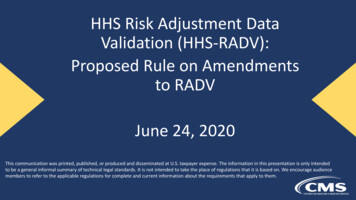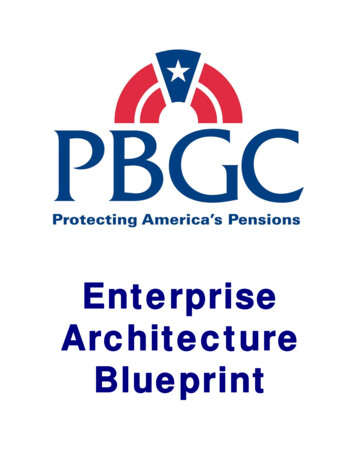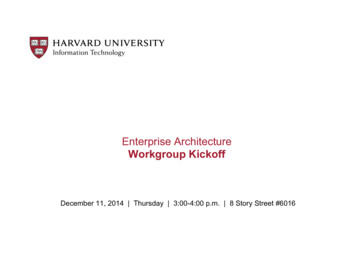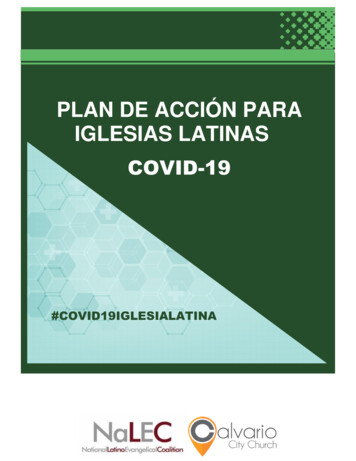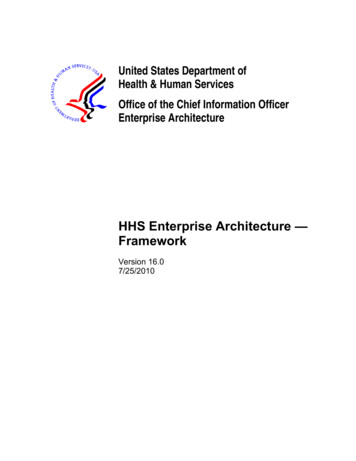
Transcription
United States Department ofHealth & Human ServicesOffice of the Chief Information OfficerEnterprise ArchitectureHHS Enterprise Architecture —FrameworkVersion 16.07/25/2010
HHS Enterprise Architecture — FrameworkVersion 16.0Table of Contents1Purpose of Document42 Overview52.1 Understanding Key Framework Concepts . 52.2 The HHS Federated EA Model . 62.3 The HHS Eight-Layer Framework Model . 82.4 Support for Baseline and Target Architecture . 93 HHS Federated Enterprise Architecture Framework103.1 EA Framework Development. 103.1.1 Framework Artifacts . 103.1.2 Framework Extensibility. 103.1.3 Governance of the Framework . 123.1.4 Evolving the Framework . 123.2 Knowledge Delivery . 124 HHS EA Metamodel by Layer144.1 Changes from the Previous Release . 144.1.1 Entity Type Changes . 144.1.2 Relationship Type Changes . 154.2 Common Modeling Features . 244.2.1 Common Entity and Relationship Attributes . 244.2.2 Recommended Properties and Relationships . 254.2.3 The Replacement Relation . 254.2.4 Online Documents. 254.2.5 UML. 254.2.6 The Taxonomy Type . 274.3 Strategy Layer . 284.3.1 Strategy Layer Description . 284.3.2 Relationship to the FEA Reference Models. 284.3.3 Entity Descriptions . 284.4 Business Layer . 334.4.1 Business Layer Description . 334.4.2 Relationship to the FEA Reference Models. 344.4.3 Entity Descriptions . 344.4.4 Workflow Related Types . 454.5 Investment Layer. 494.5.1 Investment Layer Description. 494.5.2 Relationship to the FEA Reference Model . 494.5.3 Entity Descriptions . 504.6 Data Layer . 604.6.1 Data Layer Description . 604.6.2 Relationship to the FEA Reference Models. 604.6.3 Entity Descriptions . 614.7 Service Layer. 68US Department of Health and Human ServicesOCIO—Office of Enterprise Architecture7/25/2010i
HHS Enterprise Architecture — FrameworkVersion 16.04.7.1 Service Layer Description. 684.7.2 Relationship to the FEA Reference Models. 684.7.3 Entity Descriptions . 694.8 Technology Layer . 804.8.1 Technology Layer Description . 804.8.2 Relationship to the FEA Reference Models. 804.8.3 Entity Descriptions . 814.9 Workforce Layer . 894.9.1 Workforce Layer Description . 894.9.2 Relationship to the FEA Reference Models. 894.9.3 Entity Descriptions . 894.10Facilities Layer . 934.10.1 Facilities Layer Description . 934.10.2 Relationship to the FEA Reference Models. 934.10.3 Entity Descriptions . 944.11Performance Aspect . 964.11.1 Performance Aspect Description . 964.11.2 Relationship to the FEA Reference Models. 964.11.3 Entity Description . 964.12Security Aspect. 1004.12.1 Security Aspects Description. 1004.12.2 Relationship to the FEA Reference Models. 1004.12.3 Entity Descriptions . 100Appendix A Acronyms1Appendix B Glossary1Appendix C References1US Department of Health and Human ServicesOCIO—Office of Enterprise Architecture7/25/2010ii
HHS Enterprise Architecture — FrameworkVersion 16.0List of ExhibitsExhibit 2-1 HHS Federated EA . 7Exhibit 2-2 HHS EA Framework Layers . 8Exhibit 3-1 Metamodel Extension Example .11Exhibit 4-1 Strategy Layer Metamodel Overview Diagram .28Exhibit 4-2 Business Layer Metamodel Overview Diagram .34Exhibit 4-3 Business Layer Workflow Related Types .45Exhibit 4-4 Investment Layer Metamodel Overview Diagram .50Exhibit 4-5 Data Layer Metamodel Overview Diagram .60Exhibit 4-6 Service Layer Metamodel Overview Diagram .68Exhibit 4-7 Technology Layer Metamodel Overview Diagram .80Exhibit 4-8 Workforce Layer Metamodel Overview Diagram .89Exhibit 4-9 Facilities Layer Metamodel Overview Diagram .93Exhibit 4-10 Performance Aspect Metamodel Overview Diagram .96Exhibit 4-11 Security Aspect Metamodel Overview Diagram .100US Department of Health and Human ServicesOCIO—Office of Enterprise Architecture7/25/2010iii
HHS Enterprise Architecture — FrameworkVersion 16.0Document Change HistoryVersion ReleaseNumber DateSummary of Changes0.10.212/19/2003Draft Enterprise Architecture Framework Overview, Release 10.32/5/2004Incorporates feedback from HHS re previous draft1.03/31/2004Updated Enterprise Architecture Framework Overview that reflects currentview as of 3/31/041.05/7/2004Incorporates feedback from HHS re version 1.0 as per 3/31/042.06/30/2004Expanded Framework for a Federated Enterprise Architecture Repository.Key changes include: The definition of a Federated EA Repository One common Framework for baseline and target EA Repository usage scenarios New, best practice, entity and relationship types Sections on Framework and Repository governance New document title to emphasize this is the HHS EA Framework2.18/9/2004Incorporates feedback from HHS re version 2.0. For further details seedocument “Review Comments and Disposition of revised HHS EnterpriseArchitecture —Framework, Version 2.1”3.09/30/2004This version primarily elaborates on section 3 “HHS Federated EnterpriseArchitecture Framework. Section 4 “HHS EA Metamodel by Layer,” isupdated to reflect recent changes to the metamodel.Section 3.2 is renamed “Modeling Guidelines” and now incorporates, amongother things, guidelines which replaces the retired documents “HHSEnterprise Architecture—Data Dictionary and Common TechnicalVocabulary Version 1.0 and “HHS Enterprise Architecture—Data FlowDiagrams and Technical Standards Version 1.0”Section 3.3 now elaborates more on the use of the EA Repository from theperspectives of different user groups.3.111/12/2004Incorporates feedback from HHS re version 3.0. For further details seedocument “Review Comments and Disposition of revised HHS EnterpriseArchitecture—Framework, Version 3.1”3.212/2/2004Replacing references to contractors with functional terms such as the “EATS-Team”4.012/31/2004Clarifications on target transition planning. Elaboration on the use of thefederated framework. Alignment to the EA Governance Plan. Updatedmetamodel as presented to the Model Working Group.4.12/4/2005Incorporates feedback from HHS, regarding version 4.0. For further detailssee document “Review Comments and Disposition of revisedHHS Enterprise Architecture—Framework, Version 4.1”US Department of Health and Human ServicesOCIO—Office of Enterprise Architecture7/25/20101 of 104
HHS Enterprise Architecture — FrameworkVersion ReleaseNumber Date5.03/31/2005Version 16.0Summary of ChangesIntroduces BPMN for business process modeling into the Framework. Thenew types Program and Project enable better support for CPIC relatedinformation.Enhanced modeling guidelines, particularly in the area of business processmodeling.Metamodeling guidelinesEnhanced EA repository and model structure descriptions6.06/30/2005Incorporates feedback from HHS, regarding version 5.0. Feedback responseis described in “HHS Enterprise Architecture—Review Comments andDisposition of revised HHS Enterprise Architecture—Framework, Version 5.”Changes to the metamodel, primarily removing redundant types from theStrategy layer. This was driven by the experience gained from modeling forthe OMB maturity assessment in Q3 FY2005.Description of Business Layer has been improved.Text on framework governance was replaced with a reference to theconfiguration management plan.6.18/04/2005Incorporates feedback from HHS regarding version 6.0. For further detailssee document “Review Comments and Disposition of revised HHSEnterprise Architecture—Framework, Version 6.”7.09/30/2005Major revision of the Security Aspect with impact on properties for severalobjects in the Business, Data and Application layers. Section 3 subsectionson Modeling Guidelines and Modeling Scenarios have been removed andwill instead be included in a separate “Modeling Guide” document.8.012/31/2005Added relationship listing per object type. Added highlighting ofrecommended object properties and relationships. New type taxonomy to beused as the root for various “category” types8.12/9/2006Incorporates feedback on version 8.0, from HHS. The erroneous strategylayer diagram replaced. Minor corrections and clarifications throughout thedocument.9.03/31/2006Renamed “Investment Layer” (formerly Stakeholders and Investments)Updated Data Layer to reflect FEA DRM 2.0Merged types “Goal” and “Objective” into one type called “Goal”Removed section on reports and views (This material was moved to aseparate document.)9.15/12/2006Incorporates HHS’ feedback on version 9.0. Only minor changes.10.06/30/2006Relationships for a service oriented aspects of process modeling. Typename “Logical Process HHS” to “Activity”. Minor clarifications11.012/29/2006Support for the Federal Transition Framework (FTF) metamodel and anumber of additional change requests.12.04/20/2007Enhanced support for modeling of investment related information and oftechnology information. Incorporation into entity descriptions of elaboratedattribute and relationship descriptions provided in the instructions for theFY09 EA critical partner review.US Department of Health and Human ServicesOCIO—Office of Enterprise Architecture7/25/20102 of 104
HHS Enterprise Architecture — FrameworkVersion ReleaseNumber DateVersion 16.0Summary of Changes13.06/23/2008A new approach to investment modeling based on the experiences fromFY09 and the FY10 critical partner review. Some support for segmentmodeling. Miscellaneous minor changes.14.012/15/2008Concepts in support of the HHS System Inventory15.06/30/2009Support for Records Management, FSAM/EASR report, better DataArchitecture modeling, and retirement of not used types.16.07/25/2010Support for HHS-OCIO-2009-0004, “HHS Policy HHS-OCIO Policy forManagement of the Enterprise IT System Inventory”, July 28, 2009;Simplified investment modelingUS Department of Health and Human ServicesOCIO—Office of Enterprise Architecture7/25/20103 of 104
HHS Enterprise Architecture — FrameworkVersion 16.01 Purpose of DocumentThis document provides an overview of the framework used to structure the HHS EnterpriseArchitecture Repository. This Overview describes the key concepts of enterprise architecturemodeling and how they are applied to the HHS initiative, namely: Definition of a metamodel and model elementsOverview of HHS Eight-Layer, Federated EA FrameworkIteratively evolving the metamodelDetailed descriptions of the metamodel for the following layers and aspects of TechnologyWorkforceFacilitiesPerformanceSecurityUS Department of Health and Human ServicesOCIO—Office of Enterprise Architecture7/25/20104 of 104
HHS Enterprise Architecture — FrameworkVersion 16.02 OverviewThe federated enterprise architecture repository at the Department of Health and Human Servicesimplements a common framework for enterprise information while at the same time allowingdistributed maintenance and sharing of relevant information between and within OperatingDivisions (OPDIVs) and Staff Divisions (STAFFDIVs) 1 .The fundamental principles of the EA framework can be summarized in the following threepoints: Eight-Layer architecture—provides a common structure for EA information across the entiredepartment. It allows the organization to share and leverage EA information throughout thedepartment.Federated Repository—is a repository of federated models that allows for maintenance closeto the respective information sources—department, OPDIV, or center/institute/office (C/I/O).It avoids redundancy and duplication of data entry.One Model Many Views—captures the fact that there is one model for all EA data,regardless of whether it is target or baseline. Multiple views (such as baseline or target) arethen created to support various EA stakeholders.2.1 Understanding Key Framework ConceptsFor an understanding of the Repository framework described in this document, it is important tounderstand key concepts of enterprise architecture (EA) modeling.The framework provides the concepts and guidance necessary to maintain and use the EARepository. It includes a metamodel, which defines the kinds of information that can berecorded in the repository. The kinds of data the framework describes are called entity types (or,sometimes, object types). Entity types are analogous to tables in database theory or to classes inobject-oriented theory. Conceptually related entities are grouped together into layers, describedin further detail below.Entity types represent an important concept or abstraction of the enterprise architecture; they arethe “nouns.” Each entity contains one or more attributes that describe it. Further, each entitytype may be conceptually linked to one or more other entity types in a relationship. The entitytypes, attributes, and relationships can be represented in graphic notation using the UnifiedModeling Language (UML), as we have done in section 4. Section 4.2.5 has some additionalnotes on the use of UML in this document.It is important to distinguish between the metamodel and the model, or repository. Theframework is merely a blueprint that describes what kind of data can be stored in a repository(implemented with technologies like Metis or EAMS); the actual data for each instance (calledinstance data) is contained in the EA model itself. For example, “Organization” is an entity type,while “NIH,” “CDC,” and “FDA” are instances of the type.1The term OPDIV should be interpreted to also include STAFFDIVs throughout this document, except where adistinction is explicitly made.US Department of Health and Human ServicesOCIO—Office of Enterprise Architecture7/25/20105 of 104
HHS Enterprise Architecture — FrameworkVersion 16.0A federated model is a system of cooperating models that all adhere to common rules, such as,stewardship principles and a common metamodel. Each cooperating model can be updatedindependently, including relationships to objects in other models in the federation.2.2 The HHS Federated EA ModelThe HHS Federated EA Model allows for simultaneous updates of EA information distributedacross several levels of the organization, e.g., department, OPDIV, and Center/Institute/Office(C/I/O) levels.The Federated Model also allows information of departmental scope (such as policies, standards,and common reference models) to be maintained in a departmental model, and information ofOPDIV scope to be maintained in a model for each OPDIV.The information will still be shared across the federated models allowing, for instance, a projectmanager at office-level to relate specific IT Systems to HHS policies and Federal EnterpriseArchitecture (FEA) reference models defined in the departmental model.An analogy can be made between the HHS Federated EA Model and the organization of acountry. Just as rules can be defined and services performed at national, regional, and locallevels, the HHS Federated EA Model allows, for instance, standards to be defined withdepartment-wide scope, but also refined within the scope of an OPDIV.US Department of Health and Human ServicesOCIO—Office of Enterprise Architecture7/25/20106 of 104
HHS Enterprise Architecture — FrameworkVersion 16.0Department levelprinciplesCenter levelIT StandardsUsing the EARepositoryMaintaining the EA RepositoryOPDIV levelExhibit 2-1 HHS Federated EAExhibit 2-1 illustrates (with an FDA example) the three levels of repository maintenance (upperpart). It also shows that entities can be related between submodels within the federatedrepository. The lower part illustrates how information from various submodels can be presentedin views targeted at different stakeholder needs.It should also be noted that the federated framework allows a submodel at any level to be furtherdecomposed in order to delegate maintenance to the proper subject matter experts. (Disregardillegible picture elements in Exhibit 2-1—its purpose is to illustrate the general principle of theFederated EA at HHS.)US Department of Health and Human ServicesOCIO—Office of Enterprise Architecture7/25/20107 of 104
HHS Enterprise Architecture — FrameworkVersion 16.02.3 The HHS Eight-Layer Framework ModelThe HHS EA Framework has been organized hierarchically into an eight-layer model where theinitial layers represent higher levels of abstraction identifying business and strategic concerns,while subsequent layers focus on more detailed aspects of the architecture typically moretechnical or detailed in nature. In this way, the definition of the HHS EA Framework follows theparadigm of other widely used EA frameworks such as the Zachman Framework by incorporating levels of abstraction within the architecture.The HHS EA framework layers are also similar to the Federal Enterprise ArchitectureFramework (FEAF). Four layers of the HHS EA framework map directly to the FEAF layers ofBusiness, Data, Application (i.e., Service), and Technology; while the other four HHS layers ofStrategy, Investment, Workforce, and Facilities also map into the Business layer of the FEAF.The HHS business architecture layer has been defined to delineate the business architecture inorder to capture components that are important to the departmental view of HHS.Performance and Security aspects cut across all framework layers and are identified as their owngroups within the framework. Performance and security are shown as the vertical pillars in thepicture below.Exhibit 2-2 HHS EA Framework LayersThe entity types defined by the HHS EA Framework constitute the least common denominatorthat all OPDIV EA Repositories must comply with, in order to support the HHS Federated EAUS Department of Health and Human ServicesOCIO—Office of Enterprise Architecture7/25/20108 of 104
HHS Enterprise Architecture — FrameworkVersion 16.0Repository. This means that all entity types and relationship types in the HHS EA Framework,with their respective attributes, must be supported by all OPDIV repositories.Please note that an OPDIV will have the flexibility to extend the HHS EA Framework toincorporate EA information which is specific for the particular OPDIV.A detailed description of each layer of the architecture follows in section 4 below. Subsequentreleases of this document will be updated to reflect changes to the HHS EA Framework.2.4 Support for Baseline and Target ArchitectureAll entity and relationship types in the framework have attributes that allow for the capture of thelife span of an instance. This is the foundation which allows as-is and to-be information to berecorded in the same model. Model information can then be used in views and reports to presentarchitecture snapshots from virtually any period or point in time. (Exhibit 2-1 indicates this in theApplication Transition View in the lower right corner.) The attributes that provide this capabilityare “Effective date” and “Expiration date.” For each of the two date fields there is also a statusfield to indicate whether the date is “confirmed.”US Department of Health and Human ServicesOCIO—Office of Enterprise Architecture7/25/20109 of 104
HHS Enterprise Architecture — FrameworkVersion 16.03 HHS Federated Enterprise Architecture FrameworkThis section elaborates two important aspects of a federated EA framework, namely, thedevelopment and enhancements of the framework itself and the features allowing efficient use ofthe EA model (i.e., the knowledge delivery).3.1 EA Framework DevelopmentThe framework itself must be federated in a federated environment 1 . This means that thedepartment level framework defines a minimum set of model capabilities, which must be appliedthroughout the entire enterprise. The OPDIVs, even down to C/I/O level, are still allowed to adddetail according to their unique needs.3.1.1 Framework ArtifactsThe framework comprises two groups of artifacts. One group is the actual metamodel, whichdefines the information capture capabilities of the EA Repository. The other group containsartifacts which aid in the use and capture of the knowledge. These are the knowledge deliveryartifacts, as listed below:Metamodel Artifacts:Knowledge Delivery Artifacts:Entity typesQueriesRelationship typesViewsReportsReference models (taxonomy)Scripts for automated import, export,and other repository maintenanceDocumentation, such as this documentand training material.3.1.2 Framework ExtensibilityThe department level metamodel defines the minimum set of information that must be sharedacross the enterprise. The other framework artifacts at the department level also represent what iscommon to the entire enterprise (except for some artifacts, e.g., some reports and views thatreflect the unique needs of the department level knowledge delivery).OPDIVs and C/I/Os are allowed to add to the framework according to the unique needs of eachcomponent organization. Metamodel extensions must adhere to the principle of strictextension, that is, extensions at a lower enterprise level must fully include all the capabilities ofthe level above. This ensures that the minimum requirements on information sharing, defined atthe level above are still met.1This is analogous to how laws are defined at different levels of government.US Department of Health and Human ServicesOCIO—Office of Enterprise Architecture7/25/201010 of 104
HHS Enterprise Architecture — FrameworkVersion 16.0Knowledge delivery artifacts from a higher level may not be needed at the lower level. Forexample, some reports or views may be of no interest to the lower level organization. Theseartifacts are still inherited as part of the framework, but the lower level organization has theoption not to use them, thereby offering its staff a more focused, less confusing interface to theEA Repository. It is, of course, possible for an OPDIV to add its own unique knowledge deliveryartifacts, such as views, reports, etc.Consider this framework extensibility example: The department level framework defines the entity type Business Process with the attributes“name,” “description,” “effective date,” “expiration date,” “modified by,” “modified on,”“full name,” “sensitivity,” “security categorization level,” and “source.”CMS needs the additional attributes “automated/manual,” “level of abstraction,” “triggerevent,” “process output,” “mission-essential,” and “trusted.”The extensibility of the federated EA allows CMS to define the type CMS Business Process as asubtype of Business Process and CMS Business Process entities will thus include the combinedlist of attributes (as illustrated in the figure below).Metamodel ObjectsHHS BUSINESS PROCESSNameDescriptionEffective DateExpiration DateModified ByModified OnFull NameSensitivitySecurity Categorization LevelSourceCMS BUSINESS PROCESSAutomated/ManualLevel of AbstractionTrigger EventProcess OutputMission EssentialTrustedCMS RepositoryCMS BUSINESS PROCESSNameDescriptionEffective DateExpiration DateModified ByModified OnFull NameSensitivitySecurity Categorization LevelSourceAutomated/ManualLevel of AbstractionTrigger EventProcess OutputMission EssentialTrustedNote:OPDIV level inherits all attributes of thedepartment level.Exhibit 3-1 Metamodel Extension ExampleUS Department of Health and Human ServicesOCIO—Office of Enterprise Architecture7/25/201011 of 104
HHS Enterprise Architecture — FrameworkVersion 16.03.1.3 Governan
Enterprise Architecture—Data Dictionary and Common Technical Vocabulary Version 1.0 and “HHS Enterprise Architecture—Data Flow Diagrams and Technical Standards Version 1.0” Section 3.3 now elaborates more on the use of the EA R

